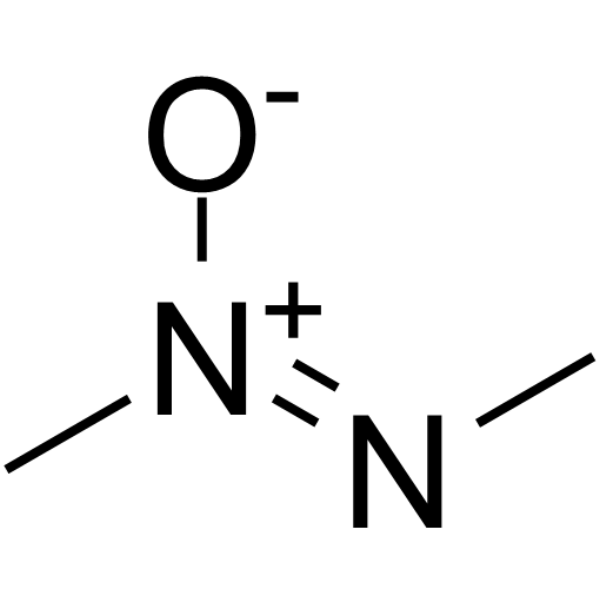上海金畔生物科技有限公司为生命科学和医药研发人员提供生物活性分子抑制剂、激动剂、特异性抑制剂、化合物库、重组蛋白,专注于信号通路和疾病研究领域。
Azoxymethane (Synonyms: 偶氮甲烷; AOM) 纯度: ≥98.0%
Azoxymethane 是一种结肠致癌物质,可导致 DNA 加合物的形成。

Azoxymethane Chemical Structure
CAS No. : 25843-45-2
| 规格 | 价格 | 是否有货 | 数量 |
|---|---|---|---|
| 5 mg (135 mM * 500 μL in Water) | ¥2650 | In-stock |
* Please select Quantity before adding items.
| 生物活性 |
Azoxymethane is a colon carcinogen which leads to the formation of DNA adducts. |
|---|---|
| 体外研究 (In Vitro) |
Azoxymethane is a colon carcinogen which leads to the formation of DNA adducts. On an equal protein basis, hepatic microsomes are much more active than SI and colon microsomes in NADPH-dependent Azoxymethane bioactivation and N7-mG adduct formation. Hepatic microsomes show the highest activity in the hydroxylation of Azoxymethane, followed by SI and colon microsomes[1]. 上海金畔生物科技有限公司 has not independently confirmed the accuracy of these methods. They are for reference only. |
| 体内研究 (In Vivo) |
Regardless of the strain, the amounts of O6-mG and N7-mG produced by Azoxymethane are highest in the liver, followed by proximal and distal colons, which have similar levels, and then by duodenum, jejunum and ileum. Results indicate that the Azoxymethane-induced DNA adduct formation in the SI and colon does not depend on bioactivation by hepatic P450 enzymes. Irrespective of the mouse strain, no aberrant crypt foci (ACF) is detected in the colons of saline-treated mice; in contrast, colonic ACF is detected in all three strains of Azoxymethane-treated mice[1]. The Azoxymethane-treated athymic mice have approximately an 11-fold lower tumor incidence than similarly treated WT animals[2]. 上海金畔生物科技有限公司 has not independently confirmed the accuracy of these methods. They are for reference only. |
| Clinical Trial |
|
| 分子量 |
74.08 |
| Formula |
C2H6N2O |
| CAS 号 |
25843-45-2 |
| 中文名称 |
偶氮甲烷 |
| 运输条件 |
Room temperature in continental US; may vary elsewhere. |
| 储存方式 |
Solution, -20°C, 2 years |
| 参考文献 |
|
| Kinase Assay [1] |
The assay for Azoxymethane-induced in vitro DNA adduct formation is performed. Briefly, microsomes (0.5 to 2.0 mg/mL) are incubated with calf thymus DNA (1 mg/mL) and Azoxymethane (200 μM) in a total volume of 1.0 mL. The assay buffer consists of 0.1 M Tris-HCl (pH 7.4), 1 mM EDTA, 20 mM MgCl2, 0.3 M KCl, and 1.5 mM NADPH. Incubations are carried out at 37°C for 60 min in a shaking water bath. An additional 30 nM of NADPH is added after the first 30 min. The reaction is stopped by the addition of 0.5 mL of ice-cold 7.5 M ammonium acetate. DNA is then extracted for tissue homogenates. Control incubations are performed without NADPH[1]. 上海金畔生物科技有限公司 has not independently confirmed the accuracy of these methods. They are for reference only. |
|---|---|
| Animal Administration [1] |
Male, 8 to 10 week old, WT-A/J, IECN-A/J, and LCN-A/J mice (8 per group) are treated with either saline or Azoxymethane (7.5 mg/kg BW, s.c.), once weekly for 3 weeks. Mice are sacrificed 6 weeks post-treatment for aberrant crypt foci (ACF) detection. The entire colon is excised. A longitudinal incision is made along the entire length of the colon, which is further cut into two equal-length segments, representing proximal and distal portions of the colon. The segments are dipped in PBS to remove fecal pellets and then kept flat between filter papers in 10% buffered formalin for at least 24 h. Subsequently, the colons are immersed in freshly prepared 0.1% methylene blue for 10 min and rinsed briefly in deionized H2O to remove excess dye. The colon is mounted carefully on a microscope slide with the mucosal surface side up and viewed under a light microscope. The ACF in the entire mucosal surface of the colon are counted blindly and independently by two investigators and recorded[1]. 上海金畔生物科技有限公司 has not independently confirmed the accuracy of these methods. They are for reference only. |
| 参考文献 |
|
所有产品仅用作科学研究或药证申报,我们不为任何个人用途提供产品和服务
